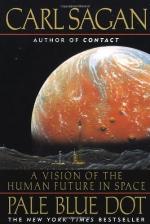
|
| Name: _________________________ | Period: ___________________ |
This test consists of 15 multiple choice questions and 5 short answer questions.
Multiple Choice Questions
1. How far out does the solar corona die out?
(a) 1200 AU.
(b) 550 AU.
(c) 5 AU.
(d) 70 AU.
2. When does Sagan think that the human race will be "on its way"?
(a) When we begin living in space.
(b) When we make contact with another intelligent species.
(c) When we begin colonizing other planets.
(d) When we reach another star.
3. What is the shape of the galaxy closest to the Milky Way?
(a) Disc.
(b) Spiral.
(c) Globular.
(d) Cluster.
4. Why do some suggest capturing asteroids in Earth orbit?
(a) To use them as space stations.
(b) To study them.
(c) To mine them for resources.
(d) To use them as weapons.
5. What moon was found to have volcanoes?
(a) Europa.
(b) Persephone.
(c) Io.
(d) Terpsichore.
6. At the time this book was written, how many Mars Observers had been flown successfully?
(a) None.
(b) One.
(c) Three.
(d) Five.
7. Sagan discusses in detail a theory that Saturn's rings are caused by what effect?
(a) Ether condensation.
(b) Gravity waves.
(c) Cosmic perturbation.
(d) Planetary tides.
8. Where was NASA's first SETI facility located?
(a) The Sierra Nevada mountain range.
(b) The Nevada salt flats.
(c) The Appalachian mountain range.
(d) The Mojave desert.
9. What characteristic of the atmosphere of Venus was initially impossible to explain?
(a) Its heat.
(b) Its high winds.
(c) Its composition.
(d) Its dark spots.
10. What types of information does SETI analyze?
(a) Radio waves.
(b) Gravitational waves.
(c) Cosmic rays.
(d) Magnetic waves.
11. Which of the following is NOT one of the missions that observed Venus using radar telescopes?
(a) Pioneer.
(b) Vesta.
(c) Magellan.
(d) Venera.
12. According to Sagan, what was the major advantage of the attitude of the government towards the Apollo project?
(a) Rocket science progressed quickly.
(b) Computers advanced in power rapidly.
(c) There was plenty of funding for space.
(d) New propulsion systems were developed.
13. Sagan says that the moon was once understood as a symbol of which of the following?
(a) Madness.
(b) The unattainable.
(c) Prosperity.
(d) Fertility.
14. The primary discipline that Sagan argues nations benefit from by investing in space exploration is called which of the following?
(a) Planetary science.
(b) Atmospheric metrics.
(c) Gestalt geosurveying.
(d) Interstellar surveying.
15. How does Sagan characterize most of the benefits gleaned from the space programs of the 60s and 70s?
(a) They were underestimated.
(b) They were unexpected.
(c) They were intangible.
(d) They were relatively unimportant.
Short Answer Questions
1. What was the name of the mission that sent the first probes to Venus?
2. When does Sagan predict that anti-matter will be mass-manufactured?
3. What does Sagan believe about weapons of mass destruction?
4. What is an astronomical unit?
5. What is the main component of the atmosphere of Venus?
|
This section contains 464 words (approx. 2 pages at 300 words per page) |

|




